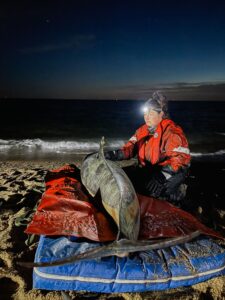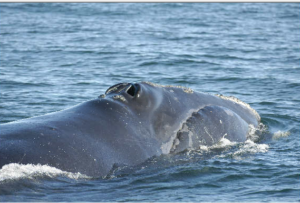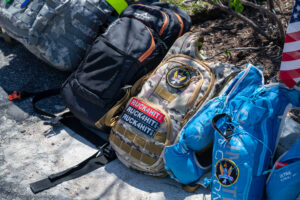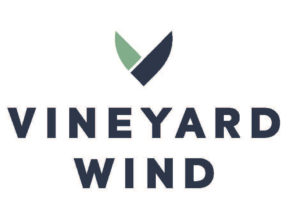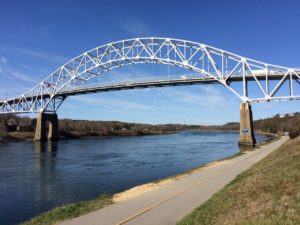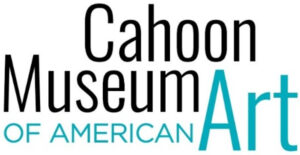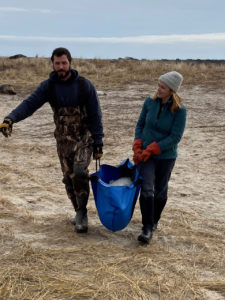
Eric Matzen and Kimberly Murray from the NOAA Fisheries Northeast Fisheries Science Center carry a seal pup to the sampling/tagging station on Muskeget. Photo: NOAA Fisheries
MONOMOY – Researchers have once again conducted gray seal pup research on local islands this winter.
NOAA researchers collaborating with other colleagues are gathering data on abundance, distribution, and health on Monomoy off Chatham and Muskeget Island off Nantucket.
Pupping season usually runs from mid-December through early February. Similar research has been conducted on the islands every year for nearly the last decade.
One research team is working on Muskeget Island off Nantucket, the largest gray seal breeding and pupping colony in the United States.
Another team is on Monomoy, off Chatham, that is part of the Monomoy National Wildlife Refuge.
Researchers capture, measure, and weigh each weaned gray seal pup and take samples of blood, mucous, hair and skin to assess health.
“We plan to place 20 satellite tags and nine acoustic tags on the weaned gray seal pups, and to collect as many health samples from pups as we can,” said Kimberly Murray, who coordinates the seal research program at the Northeast Fisheries Science Center’s Woods Hole Laboratory and leads the team on Muskeget Island.
“Our goal is to sample 50 pups on Muskeget and 100 on Monomoy, but that depends on factors such as weather conditions, scheduling, and departure of weaned pups.”
The team also sampled 14 weaned gray seal pups on Seal Island in Maine.
They placed five satellite tags and two acoustic tags on seal pups there to learn where those pups go.
On January 30, researchers sampled and tagged 15 gray seal pups on the Coskata-Coatue Wildlife Refuge, which includes Great Point Light, on Nantucket and collected scat, or seal poop, for microbiome/microplastics/food habits work.
The satellite tags will remain on the pups for several months to reveal how long the pups stay in the pupping colonies and where they go after leaving.
Some tags also collect the animal’s dive behavior to disclose potential foraging areas.
Researchers are interested in the amount of time spent in particular areas of U.S. and Canadian waters. This will help them understand seasonal changes in abundance and evaluate risk of fisheries interactions.
The acoustic tags will stay on from 1 to 2 years. If receivers throughout the Gulf of Maine and the Mid-Atlantic detect the tags, scientists will get information on the seals’ seasonal presence and survival.
Pups are captured on land, not in the water. Scientists outfit each captured seal with a numbered flipper tag for identification. The entire process from capture to release usually takes less than 20 minutes.
In 2013, researchers from Tufts University began conducting long-term studies of the influenza A virus in gray seals.
Their goal is to understand the prevalence of the virus in the population, how it transmits, and if it might affect other wildlife.
Researchers expanded their health studies in 2015 to include seals at Monomoy, and in 2018 added Great Point on Nantucket.
The team is also looking at morbillivirus, the primary cause of Northeast seal mortality in 2018.
“We want to understand what forms of virus circulate in the wild, why some animals are more susceptible to disease than others, and what factors impact disease spread and severity,” said Wendy Puryear, who is part of the Jonathan Runstadler Laboratory and is leading the project’s gray seal influenza work on Monomoy.
Each year the team has found that about 10 percent of the seal pups show evidence of influenza A.
A higher percentage have antibodies for the virus. Preliminary results suggest that dominant forms of influenza exist within the population, but a broad range of subtypes can infect gray seals.
The scientific team for the 2020 gray seal pup studies at Muskeget comprised researchers from NOAA’s Northeast Fisheries Science Center, Tufts University, Marine Mammals of Maine, and Atlantic Marine Conservation Society.
Researchers from the University of Connecticut, Mystic Aquarium, National Marine Life Center, Virginia Aquarium & Marine Science Center, the National Aquarium, and the Seacoast Science Center also helped with field work at Monomoy.
University of Maine researchers are conducting research on samples collected by the field teams.
Monomoy National Wildlife Refuge is operated by the U.S. Fish and Wildlife Service.






